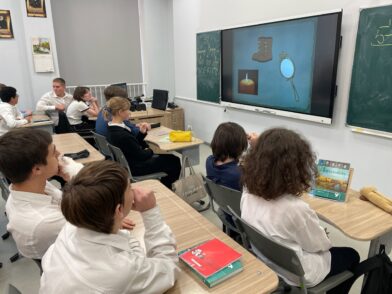Современный подход к обучению английскому языку требует использования на уроке эффективных коммуникативных задач, побуждающих учеников к высказыванию на неродном языке. Внутреннее желание вступить в диалог с учителем или одноклассником тесно связано с индивидуальными способностями самого ребенка. Поэтому необходимо формировать критическое мышление, которое отвечает за творческое воображение ученика. Во многом именно воображение вдохновляет и побуждает к высказыванию.
В педагогике существует много способов и приемов развития воображения школьников. Эффективные инструменты развития воображения на уроке – звук и цвет. Но что парадоксально, само отсутствие звука и цвета также прекрасно активизирует воображение учащихся. Рассмотрим эти явления на примере темы «The Power of Silent Black-and-white movies» («Сила немого черно-белого кино»), предложенной ученикам 10-11-х классов в блоке уроков Films.
На уроке школьники рассматривают элементы, которые используются в современном кинематографе для создания целостного восприятия сюжета фильма: изображение, костюмы актеров, жесты, мимику, музыкальное сопровождение, звуковые эффекты. Однако из истории кинематографа известно, что самые первые фильмы были черно-белыми и без звукового ряда. Но, несмотря на это, они интересны современному зрителю. В чем их привлекательность? Они должны были в первую очередь отличаться блестящей игрой актеров и предлагали зрителю свободу воображения. Ребята должны выступить в роли звукорежиссеров и сценаристов отрывка из немого кино.
Цель урока: формирование речевой компетенции учащихся по теме Films.
Задачи
Познавательный аспект: определение роли изображения и звукового сопровождения в формировании целостного восприятия кинофильма, расширение общего кругозора школьников, стимулирование деятельности учащихся путем обращения к дополнительным источникам информации, включая ресурсы Интернета.
Учебный аспект: активизация лексического материала по теме Films, совершенствование навыков поискового чтения, умения выполнять творческую работу.
Развивающий аспект: развитие у детей психических функций, связанных с речевой деятельностью: логическое мышление, память, внимание, восприятие, развитие навыков критического мышления, поддержание положительной мотивации к изучению иностранного языка.
Воспитательный аспект: приобщение к мировой культуре, развитие умения работать в команде, активно слушать, а также формирование потребности в самовыражении и самоактуализации.
Лексический материал урока:
mime, facial expression, physical gesture, silent films, it makes me feel…, audience, to influence, setting, «visual clues», background music, purity, perception, sound producers, script writers.
Оснащение урока
Персональный компьютер (2 шт.).
Мультимедиапроектор.
Экран.
Материалы:
Диск с фрагментом из фильма «Amazing Grace».
Диск с фрагментом из фильма Чарли Чаплина «CITY LIGHTS».
Аудиофайлы с инструментальной музыкой разного характера (например, Frank Sinatra «The tone poems of colors»).
Ход урока
I stage
Greeting. Dear student how are you today? I feel excited. I feel terrible. I feel tired.
I’d like you to read the words on the first slide. What do they correspond to?
(Show different colours on the slides and ask the question.)
What feelings does each colour evoke?
It makes me feel… slow/hurried/happy/sad/angry/disappointed/excited/surprised/worried/relaxed/.
What images come to your mind when you see yellow color? (purity, love, sunshine and so on). So we can influence person’s mind and spirit looking at different colours.
II stage
We continue discussing the secrets of movie making. Color is one of the elements that helps the audience to understand the story. What are the other elements? You are going to watch a clip from a movie, and you should think about different elements are used to help tell the story.
Play a clip from the film «Amazing Grace» (or any other film), which lasts roughly 3 minutes.
These elements include the images, the dialogue, the music and sound effects, costumes of actors and actresses.
Write these elements on the board. Ask students to talk about the elements listed on the board. Here some examples you might use:
Images: gestures and facial expressions help the audience understand what is happening.
Music/Sound: What type of mood the music seems to set when it starts and stops?
Words: What types of things people say and whether what they say helps further the story.
So filmmakers use all these different elements to tell stories. However, there are films that don’t have all the given elements.
III stage
What is a silent movie? A silent movie is a movie without sound. What colours are these films? Right, they are black and white. You can see only image and understand the story (the message) of the film. Would you prefer watching color film or silent black-and-white films? Why? Explain your answer.
IV stage
Now I’d like to know if you are aware of the history of silent movie making. Read the statements and define if these statements are True or False. Now we’ll read the text and see if you are right.
1) Silent and black-and-white films were made in Hollywood.
2) His first comedy film «Making a living» was made in the nineteenth century.
3) Silent films were aided by dialogues and music.
About 100 years ago Los Angeles was a little city with orange forests and great weather. But one day in 1908 a group of people from Chicago came to Los Angeles to shoot a film. Since that day a lot of directors, producers, actors and workers have been coming to Los Angeles. Now there are many big film companies in the USA: Warner Brothers, Paramount, Columbia Pictures, Universal and others. Silent and black-and-white films were made in Hollywood. It gave us a lot of famous actors and actresses. Can you name famous actors and actresses starred in silent films? The most well-known was Charlie Chaplin. He was born in 1889 and died in 1971. He was an American actor, producer, director and composer. His parents were actors too. In 1913 he began to star in the American company «Keystone» he was a comedian actor. His first comedy film «Making a living» was made in 1914, then «Catching in the Rain». But he wanted to play real people. In the films «The Tramp», «The Bank» we see lonely, unprotected people. There were tears and laugh in his film «The Kid». Charlie Chaplin got two Oskar awards: in the twenties and in 1972. Silent films in which he starred, were aided by explanatory titles and music. Chaplin’s films have always been popular with the cinema-goers.
Now let’s see the right answers.
Now you are going to watch a scene from a silent movie. Tell students that as they watch, they should think about what is happening and how they are able to understand the story even though there is no sound.
Play the clip from Charles Chaplin’s CITY LIGHTS.
Play the last scene from the film without music. The clip lasts roughly 3 minutes. http://www.youtube.com/watch?v=kpeiPbjDlDs
Ask students what has happened in this clip:
1) Is Charlie poor or rich?
2) Who is Cherrill (the young girl)?
3) Is Cherrill happy to see him again?
4) Did they meet before?
Ask what helped them to understand the story (facial expressions, gestures, the setting, and other «visual clues»).
VI stage
Explain to students how background music (originally played live) helped create the main emotion in early silent films. Ask students to discuss the emotions the music is intended to bring the listener. Ask how the music accomplishes the task of making an emotion come to life.
Next, show them the film clips again, and (if possible) play some of the silent movie music at the same time. Ask, «Which music matches the film? How can you tell?»
VII stage
Tell students they will be sound producers and script writers. In groups they will perform the dialogues and special sound effects for the clip they’ve just seen. Remind them to think about the steps, actions, noise of the street around. Their scenes will be inspired by one of the silent movie clips. Tell students they will «publish» the piece of writing by reading it aloud with chosen clips of silent movie. The scenes they write must include interesting action words, memorable details, interesting dialogue, and excellent word choices. Students use two personal computers to fulfill the task.
VIII stage
Silent Movie presentations with subsequent critical evaluation. Your students will certainly enjoy performing their scenes in small groups with their dialogues, sound effects and music playing as background music.
IX stage
Thank your students and make a conclusion asking what is the power of silent black and white films and what role sound and image play in perception of a film.
Юлия ВАРЛАМОВА, учитель английского языка средней школы №97, лауреат конкурса «Учитель года России-2007», Ижевск, Республика Удмуртия
I IIVVIVII







 Выбор читателей
Выбор читателей






Комментарии